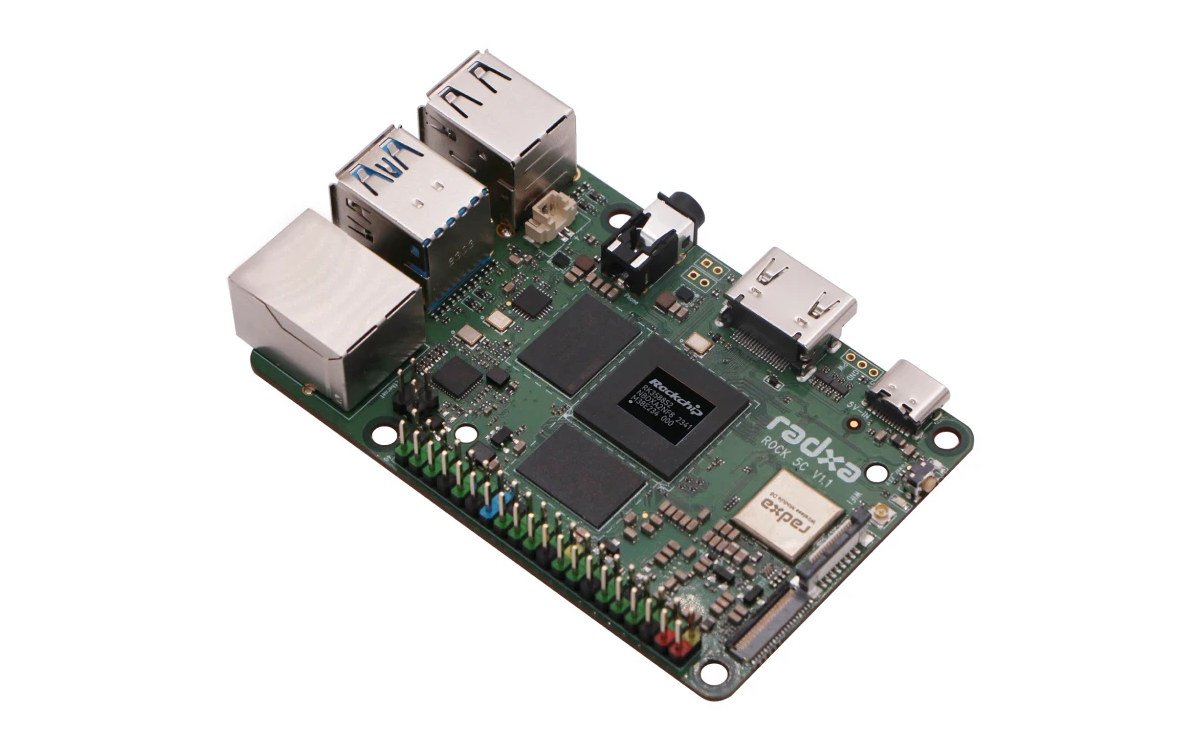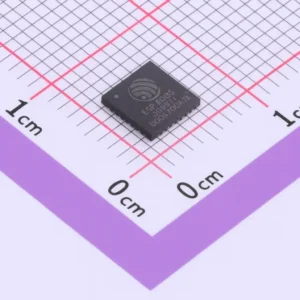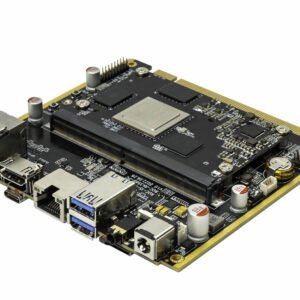RK3588S2 Rockchip RK3588S2 High-Performance Edge & Multimedia Processor
- 6 TOPS on-chip NPU for private, low-latency AI at the edge.
- 8K60 decode + 8K30 encode for premium playback, recording, and signage.
- Dual 48MP ISP with HDR/3DNR for multi-camera vision systems.
RK3588S2 SoC Overview, Specifications & Applications for AI, 8K Video, and Multi-display Systems
The Rockchip RK3588S2 is a high-integration application processor purpose-built for next-generation edge AI, rich multimedia, and multi-display products. Fabricated on an 8nm process, it combines a big.LITTLE CPU complex—quad Cortex-A76 + quad Cortex-A55—with a powerful Arm Mali-G610 MP4 GPU and an integrated 6 TOPS NPU. Together with 8K video decode, 8K encode, and a dual 48-megapixel ISP, RK3588S2 delivers desktop-class responsiveness in fanless embedded designs such as ARM-based mini PCs, AIoT gateways, digital signage players, NVRs, and advanced HMI terminals.
On the graphics side, the GPU supports OpenGL ES 3.2, Vulkan 1.1/1.2, and OpenCL up to 2.2, enabling modern 3D pipelines, GPGPU compute, and smooth UI composition. Display subsystems drive multi-screen outputs up to 8K@60fps through interfaces that include HDMI 2.1, eDP, DP, and MIPI-DSI, while an HDMI 2.0 input allows ingest up to 4K@60fps—ideal for video walls, capture/convert appliances, and collaboration endpoints.
For AI workloads, the on-die NPU reaches up to 6 TOPS and accelerates common data types—INT4/8/16, FP16, BF16, TF32—across a triple-core architecture, making it practical to deploy models for vision, speech, and analytics without a discrete accelerator.
Media engines handle H.265/VP9 8K@60 decode, H.264 8K@30 decode, AV1 4K@60 decode, and H.264/H.265 8K@30 encode, with high-quality JPEG processing. A 48MP ISP with HDR, 3A, 3DNR, LSC, sharpening, dehazing, fisheye and gamma correction supports multi-camera inputs over MIPI CSI-2 and DVP—perfect for smart cameras, vision-guided robotics, and multi-sensor fusion.
I/O is equally comprehensive: PCIe 3.0/2.0, USB 3.1/2.0 with Type-C, SATA 3.0, RGMII Gigabit Ethernet, plus the aforementioned display and camera interfaces. RK3588S2 runs Android and Linux, easing application portability and upstream integration.
Specifications
| Parameter | Value |
|---|---|
| Process technology | 8nm low-power process. |
| CPU | 8 cores total: 4× Arm Cortex-A76 + 4× Arm Cortex-A55 (each with NEON). |
| GPU | Arm Mali-G610 MP4 with dedicated 2D hardware engine. |
| Graphics APIs | OpenGL ES 1.1/2.0/3.1/3.2; Vulkan 1.1/1.2; OpenCL 1.1/1.2/2.0/2.2 (page lists up to 2.2). |
| NPU | Up to 6 TOPS, triple-core; supports INT4/INT8/INT16/FP16/BF16/TF32. |
| Video decode | H.265 & VP9 8K@60fps; H.264 8K@30fps; AV1 4K@60fps; AVS2 supported. |
| Video encode | H.264/H.265 up to 8K@30fps; high-quality JPEG encode/decode. |
| Display outputs | eDP/DP/HDMI 2.1/MIPI-DSI; multi-screen up to 8K@60. |
| Display input | HDMI 2.0 RX up to 4K@60fps. |
| ISP / Imaging | Dual 48MP ISP with HDR, 3A, 3DNR, LSC, sharpening, dehazing, fisheye, gamma; multiple MIPI CSI-2 and DVP. |
| 2D engine | High-performance 2D image processing module with MMU. |
| High-speed I/O | PCIe 3.0/2.0, USB 3.1/2.0 (Type-C), SATA 3.0, RGMII GbE. |
| Operating systems | Android and Linux support. |
| Target applications | ARM-based PCs, edge computing devices, PMIDs, multimedia & AIoT devices. |
| Relative to RK3588 | Optimized version emphasizing enhanced power efficiency while maintaining similar performance characteristics (power and packaging tweaks for market segments). |
| Multi-display | Multi-screen composition and output up to 8K@60fps. |
Applications
1) Edge AI boxes and gateways.
With 6 TOPS of on-chip NPU throughput, the RK3588S2 can deploy object detection, classification, OCR, and speech pipelines directly on the device. The CPU/GPU/NPU balance supports mixed workloads—pre/post-processing on CPU, DNN inference on NPU, and visualization/overlay via GPU—reducing cloud dependency and latency for retail analytics, anomaly detection, and smart building controllers.
2) 8K/4K digital signage and video walls.
Native 8K@60 decode (HEVC/VP9) and 8K@30 encode, multi-display engines, and HDMI 2.1/eDP/DP outputs enable premium signage players, theater-grade content playout, and tiled canvases. HDMI 2.0 input up to 4K@60 allows ingest from PCs or cameras for live preview, PIP, or transcoding.
3) Network video recorders & smart cameras.
A dual-48MP ISP with HDR and 3DNR plus multi-camera MIPI CSI-2/DVP inputs suits multi-stream NVRs, panoramic cameras (with fisheye correction), or machine-vision deployments. Hardware H.265/H.264 encoders provide efficient recording/streaming with low CPU load.
4) Industrial HMI and control terminals.
The GPU’s modern APIs (OpenGL ES 3.2/Vulkan) and 2D engine make for fluid UIs on high-resolution panels. High-speed I/O (PCIe, USB 3.1, SATA, GbE) integrates SSDs, expansion cards, and field interfaces, while Android/Linux support simplifies app development.
5) Collaboration endpoints and capture appliances.
Mix HDMI input with local rendering and 8K/4K encode/decode to build conference codecs, lecture capture, KVM over IP, and broadcast tools—leveraging the NPU for background blur, denoise, or speaker tracking.
Why choose RK3588S2?
Balanced performance per watt.
The 8nm process and big.LITTLE design deliver PC-class burst performance with embedded-class efficiency. Compared to the RK3588, RK3588S2 focuses on improved power management to serve thermally constrained systems without sacrificing headline capabilities.
Full-stack media and vision.
From 8K60 decode/8K30 encode to the 48MP ISP and a feature-rich 2D/3D graphics pipeline, the SoC addresses the entire capture–process–render chain—reducing external BOM and power.
Production-ready connectivity.
With PCIe 3.0, USB 3.1/Type-C, SATA 3.0, and RGMII, designs scale from compact fanless boxes to modular systems with NVMe SSDs, Wi-Fi 6/5G add-ons, and high-speed peripherals.
RK3588 vs RK3588S vs RK3588S2 Comparison
| Feature / SoC | RK3588 | RK3588S | RK3588S2 |
|---|---|---|---|
| CPU cores | 4× Cortex-A76 + 4× Cortex-A55 (DynamIQ) | 4× Cortex-A76 + 4× Cortex-A55 | 4× Cortex-A76 + 4× Cortex-A55 |
| GPU | Mali-G610 MP4 (same family) | Mali-G610 MP4 (same family) | Mali-G610 MP4 (same family) |
| NPU (ML) | ~6 TOPS | ~6 TOPS | ~6 TOPS |
| Process node | 8 nm | 8 nm | 8 nm |
| Memory support (typical) | LPDDR4/LPDDR4X/LPDDR5 (board-dependent) | Primarily LPDDR4/LPDDR4X on cost/power-optimized boards | LPDDR5 supported; newer boards often use LPDDR5 (higher bandwidth) |
| Video decode / encode | 8K-class decode/encode; robust HW VPU with AV1/HEVC (revision-dependent) | Same core VPU as RK3588, but S series typically trims some I/O combos | 8K-capable; modern platforms emphasize 8K + multi-display |
| Typical PCIe / I/O | Most generous (more PCIe lanes, SATA, HDMI RX/TX, multiple DP) | Reduced vs. RK3588 (fewer SATA/PCIe lanes, fewer display ports) | Contemporary selection—many vendor boards support NVMe/PCIe (e.g., ODROID-M2) |
| Typical use cases | High-end SBCs, mini-PCs, media servers, edge AI | Cost/power-optimized products where some I/O is unnecessary | Next-gen SBCs & embedded devices needing LPDDR5, NVMe, and 8K multimedia |
Note: Exact memory types, I/O counts, and codec details vary by board design and firmware. The table reflects commonly observed, practical configurations for product selection.
Design notes & integration tips
-
Multi-display composition: Use the SoC’s multi-screen pipeline to drive independent HDMI/DP/eDP/MIPI outputs at mixed resolutions, with 8K@60 maximum aggregate capability. This enables one board to feed both a main 8K panel and auxiliary status displays.
-
Video ingest and re-encode: HDMI 2.0 RX up to 4K@60 lets you capture external feeds for live processing—e.g., overlay AI inference results, scale or transcode to H.265, then push to a CMS or RTMP endpoint.
-
Model selection for the NPU: Favor quantized INT8 or INT4 variants to maximize throughput on the triple-core NPU; fall back to FP16/BF16 for accuracy-critical paths. The multi-type support eases porting of mainstream frameworks.
-
Camera pipelines: Pair the dual 48MP ISP with synchronized MIPI CSI-2 sensors for stereo or multi-FOV systems; leverage built-in HDR, 3DNR, LSC, and fisheye correction to reduce external ISP costs.
-
Storage and bandwidth: SATA 3.0 or PCIe-attached NVMe provides headroom for multi-stream 4K/8K recording; USB 3.1 expands to capture dongles or high-speed peripherals without saturating CPU or GPU.
Competitive positioning
Within Rockchip’s lineup, RK3588S2 sits as an optimized, power-efficient variant of the RK3588 family, preserving the octa-core CPU, Mali-G610 MP4 GPU, 6TOPS NPU, and flagship media blocks while fine-tuning power behavior and, depending on SKU and board design, peripheral combinations for targeted markets (mini PCs, signage players, AI boxes). For teams standardizing on Android or Linux, it provides a stable software target with strong community momentum around RK3588-class devices.
Summary
Rockchip’s RK3588S2 delivers an uncommon combination of 8nm efficiency, octa-core compute, modern 3D graphics, 6 TOPS edge AI acceleration, 8K-class media, and broad I/O. If your product brief mixes multi-camera vision, analytics, capture, encode, and multi-display output—all in a compact thermal envelope—RK3588S2 offers the right balance of headroom and integration to simplify your BOM and accelerate time-to-market.
Specification: Rockchip RK3588S2 High-Performance Edge & Multimedia Processor
|





